By Ali Clark, Senior Curator Oceania and Jane Miller, Community Engagement Manager
In August 2023, Rising Tide: Art and Environment in Oceania’ opened at the National Museum of Scotland. The exhibition included the artwork ‘Bottled Ocean 2123’ by George Nuku which involved 400 volunteers in its construction. Here two members of the exhibition team consider how working with communities in the construction of exhibitions can help engage people in environmental issues.
The Exhibition
‘Rising Tide: Art and Environment in Oceania’ considers how life depends on the ocean and presents various ways in which individuals within Oceania are working to protect it through the medium of artistic practice. It highlights the vulnerabilities of Oceanic countries to climate change whilst showcasing the strength and resilience of its communities.

Copyright National Museums Scotland
Through the artworks presented, the exhibition addresses themes of human resilience, innovative practice, creative responses and acts of protest. In particular the exhibition features several artworks that consider how Indigenous peoples in Oceania have always innovated, using materials found in their natural environment to make cultural objects. It focuses on objects made from introduced man-made materials such as plastic and glass to consider how people are using these materials as a way of cleaning up their environment, raising awareness of pollution and practising culture.
In designing the exhibition, we also wanted to make these global issues of environmental change in Oceania relevant to our local audience, demonstrating how the issues presented in Oceania have relevance to the lives of people ‘here’ – in Edinburgh. Through artworks such as George Nuku’s ‘Bottled Ocean 2123’ we hoped to be able to show visitors how these issues were relevant to them, with the intention of inspiring them to become active agents in the next chapter of environmental action.
Bottled Ocean 2123
‘Bottled Ocean 2123’ imagines 100 years into the future. The ice caps have melted, the planet is flooded and plastic permeates all life on Earth. Bottled Ocean transforms the plastic that we use and throw away every day into Māori cultural treasures including a waka (canoe) and sacred marine animals. The artwork sets out to change our relationship with plastic, treating it as a treasured resource rather than something to be discarded. Nuku argues that the problem is not the plastic bottle itself but our relationship with it. He argues that because we see the empty plastic bottle as a thing of waste with no further use we become repelled by it. By transforming it into a thing of beauty, he asks us to become enchanted with it and to consider its whakapapa (genealogy). Here Nuku is drawing on the indebtedness of plastic to crude oil — a fossil fuel that is formed over thousands of years — to show that plastic is both the oldest and the newest material we have. He is reminding us that in order to create change in the future, we must pay attention to the past.
Community Engagement

Photograph by Jane Miller: Making found object beach art with young people from Pilton Young People and Children’s Project
We saw an opportunity to engage children and young people from North Edinburgh in the process of working with the artist George Nuku for the installation of Bottled Ocean 2123. Having worked in this urban and coastal area before, we knew environmental themes were being explored by local youth organisations to support resilience and build confidence, and their connection to the sea and coastal life echoed the concerns of those living in Oceania. However, we also knew the challenges they faced in this area of high deprivation, where these issues can seem less urgent than coping with the cost-of-living crisis.
To engage the young people with Bottled Ocean in an accessible way, we decided to focus on outdoor learning, art and creativity inspired by found and recycled materials, and chose to work with two local youth groups – Pilton Young People and Children’s Project (aged 8-11) and Granton Youth (aged 12-25) located near the Firth of Forth in Edinburgh. Our first session — a beach comb on a freezing February day to hunt for plastic debris on the Scottish coast — was a bold move, but hot chocolate and a campfire warmed the young people up, and we were excited to see what we would make with our finds.
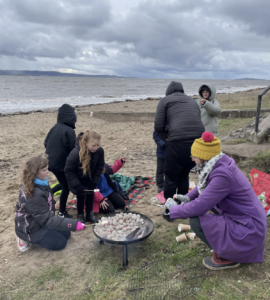
Photograph by Jane Miller: Toasting marshmallows to get warm after a beach comb
Working with environmental artist Hannah Ayre, we turned plastic into art, echoing the themes of George’s installation to reframe it as a high-status medium. The young people then visited the National Museums Collection Centre to investigate objects made from recycled coastal material destined for Rising Tide. Here, they witnessed first-hand the plastic debris found inside a whale washed up on a Scottish beach.
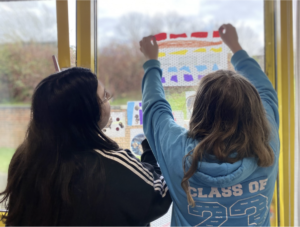
Photograph by Jane Miller: Displaying artwork made from recycled materials working with artist Hannah Ayre
For Bottled Ocean, community is really key to how the installation is produced, with Nuku bringing together local teams of volunteers to help produce and construct the installation.
In July 2023 during the installation phase, George visited the youth groups’ location to work together with them to create pieces for the artwork – turning plastic bottles into glittering jellyfish, which a team of volunteers then helped George to install. The Museum also ran family drop-in workshops in the Learning Centre at the National Museum of Scotland to make more jellyfish.We then worked with a team of adult volunteers which included students from Edinburgh College of Art and people from The Welcoming, an Edinburgh based charity for recent migrants, to build the installation. Overall, we worked with around 400 individuals to realise the installation which took 16 days to install.
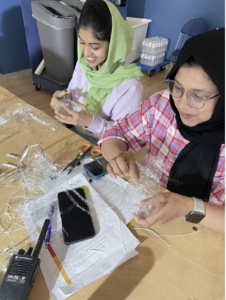
Photograph by Jane Miller: Volunteers from the Welcoming Project helping to create jellyfish for Bottled Ocean out of plastic bottles
The opening
For the opening ceremony in September, young people and adult volunteers were invited to the Museum to help George deliver a welcome blessing for the exhibition. Part of this welcoming involved performing a Māori haka (a ceremonial dance) to bless the space and to welcome people into that space. The children, while at first nervous to perform in public, eventually warmed up to the idea of being part of something so significant, and excitedly discussed bringing family and friends back to Rising Tide.
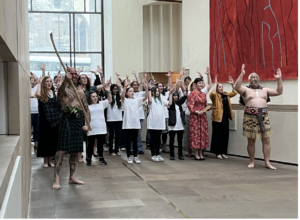
Copyright National Museums Scotland
The reason that George involves so many people in the production of his installations is that he believes that it is only through the act of making and participating can we change people’s mindset. In addition to the transformation of plastic waste into a beautiful art piece, each volunteer also transformed themselves. They become campaigners for climate justice who are able to communicate the environmental message of the artwork to audiences in their local environment and make the issue of environmental change in Oceania relatable to audiences here in Scotland.
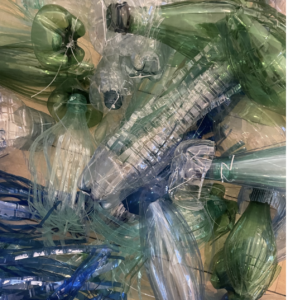
Photograph by Jane Miller: Plastic bottles in the process of being transformed into artwork for Bottled Ocean.
We hope that the message of valuing discarded materials and how local choices can affect the lives of others across the world, help these young people understand the positive actions they can take to combat the climate crisis and connect them to a shared global goal.
If you’d like to learn more about National Museums Scotland’s wider approach and responses to sustainability, climate and biodiversity loss, please visit our Sustainability web page.
About the Authors
 .
. 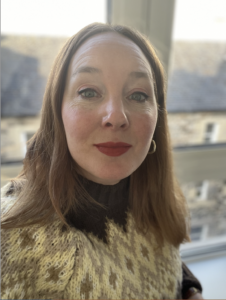
Dr Ali Clark. Jane Miller
Dr Ali Clark is Senior Curator Oceania at National Museums Scotland. She has 15 years experience working in the museum sector including the British Museum and Museum of Archaeology and Anthropology, University of Cambridge. Since 2009 she has worked collaboratively with indigenous communities in Oceania to document the contemporary legacies of colonial collecting in the region. Her research is focused on Australia and the Pacific Islands where she has a particular interest in environmental change, biocultural collections and the history of collections.
Jane Miller is Community Engagement Manager at National Museums Scotland. She has worked at NMS for around 20 years in different roles, and for the last 4 years has been managing the community engagement team to deliver a range of accessible and inclusive projects and programmes. She has a background in art history and loves exploring sustainable ways to celebrate and promote art and design. She is passionate about engaging diverse people with museum collections in authentic and meaningful ways, leading to better representation, improved understanding of the world around them and enhanced wellbeing.







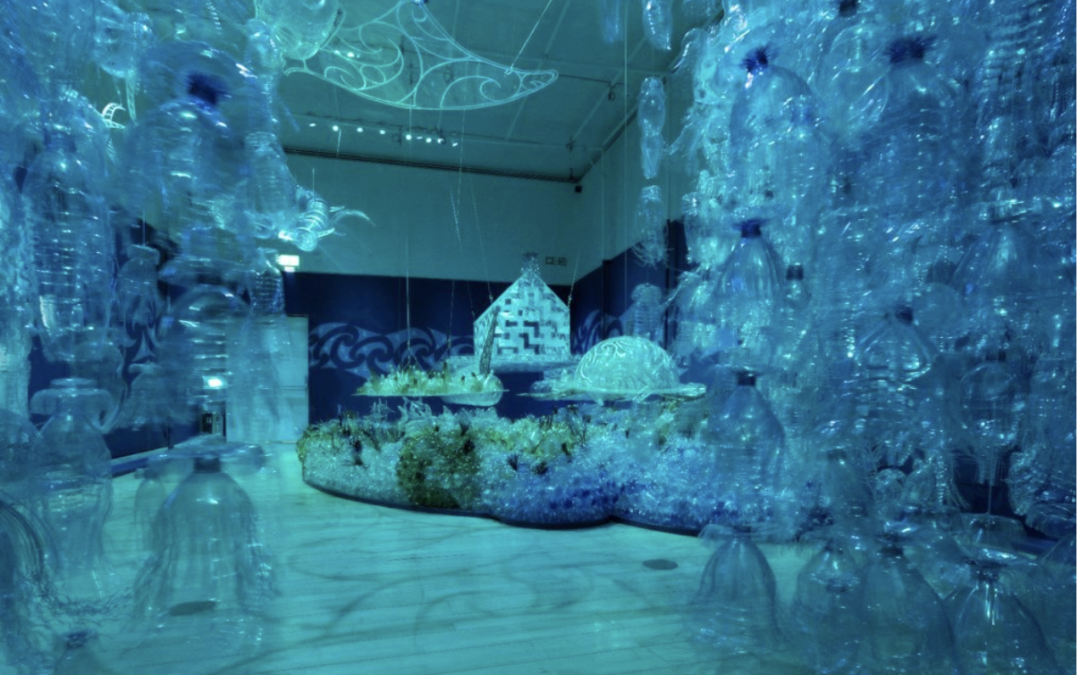
Recent Comments